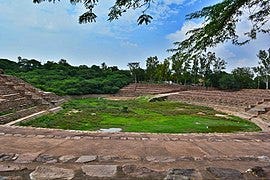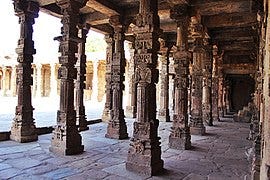Why am I writing this article?
There was a short Twitter interaction with two users that I follow on Twitter: Vajrapani and Bhaashaakosh where the latter shared a map of Delhi in 1840. I was surprised to see a place called “Inderput” in the map and discussed with Vajrapani ji if this place is Indraprastha or not (basically Indra → Inder and prastha → pat/put. This is similar to other 4 “prasthas” i.e. Svarṇaprastha-Sonipat, Pāṇduprastha-Panipat, Vyāghraprastha-Baghpat and Tilaprastha-Tilpat. However, Bhaashaakosh ji thinks that the etymology might be different.
TLDR: etymologies are interesting (not exactly a TLDR but that’s what discussions like this make me think so 😈)
For a long time, I was interested in how the name Delhi came to be. Earlier I heard “somewhere” that the name came from “Dehleez” which is a Farsi word that means threshold or army camp. It is one of the long list of things that Sultans of Delhi and Timurids (called by others as Mughals) contributed to the uncultured Indian society.
Later on I found some good Twitter accounts and joined a Discord server where I met people from whom I have learnt a lot about my uncultured ancestors and primitive Indian society. /s
This section serves as Introduction not only for this article but Dyaushpatrika as well.
NOTE: I hate reading but I am trying to develop a habit to read books and articles so this substack is basically my notes copy that has been prepared to be shared with others. This article mainly uses stuff from Wikipedia articles that I have properly cited.
Anangpāl Tomar
I was born and brought up in Delhi. In my 14 years of schooling, I never heard about this person’s name. I did meet some people with the surname Tomar but didn’t realise at that point of time that the Tomars (a Rājpūt clan) has a strong connection with Delhi.
Before I continue further there are two Anangapāl Tomars: the founder Angapāl I and Anangpāl II1. It is the latter who I am going to talk about in this section.
Anangpāl established a fortress called Lal Kot2 i.e. “red fort” in 11th century at a location what is now called the Qutub-Mehrauli complex. A city grew around this fort and it was called Dhillika.
Tomars continued to rule the city until they were defeated and replaced by Chāhāmanas (another Rājpūt clan) now known as Chauhāns. Pṛthvīrāj Chauhān was from this clan.
Let’s move on to the interesting part; Anangpāl might be the person who brought the famous Iron Pillar of Delhi3 from somewhere else. The pillar has two distinct inscriptions: a Sanskrit inscription written in Gupta (Later-Brahmi) script by King Chandragupta II and an inscription by Anangpal:4
Samvat Dihali 1109 Ang Pāl bahi
Scholars think that it means: “Ang Pāl peopled Dilli” i.e. Ang established and populated a city called Dihali.
We don’t see Dhillika and Anang but we do see “Dihali” and “Ang”. Now my first noob take in the article: It is possible that Anang and Dhillika might be the Sanskrit versions (i.e. follow Sanskrit conventions for names) and Ang and Dihali might be the Prakrit versions of the names of the king and the city respectively. Most likely, Dihali eventually became Dehli and Dilli.
Anything important from Dhillika?
When I was taught history of my birth place in school, it started with the Delhi Sultanate as if nothing significant existed before that. In this section, I will tell you about some interesting locations of Delhi from that time period.
Sūrajkuṇd
Delhiites know about the lake thanks to the popular Sūrajkuṇd Melā but most of them (including me until few months ago) don’t know about the history of the lake.
It was built by Sūrajpāl Tomar to worship Surya Deva5. It is said that there was a temple dedicated to him near the lake which is quite possible as lakes and tanks like this were often constructed beside a temple. (Anyway, Nice pun you have there for the lake’s name, Sūrajpāl jī). It was also used as a place to rest after a long day of hunting by the Tomars.
27 Hindu and Jain Temples
Unfortunately, we don’t know how beautiful they looked but they were destroyed to build the Quwwat-ul-Islam Mosque.
The Iron Pillar
Iron Pillar is bacc! What’s more to discuss about the pillar? So one of the temples was huge compared to others and served as the main temple at the site. The temple was known as Rai Pithora according to some people. Temples (I don’t know if this applied to all of them or some) used to have a pillar in front of them called Garuda Stambha or Garuda Dhvaja.6 The Iron Pillar might have served as the Stambha for this grand temple as it has a socket on its top which according to some people was used to place the murtī of Garuda.
(Yes, I haven’t discussed about the metallurgical feat of the pillar as it well known)
Anangpur Dam
Dams, canals, tanks and ponds were constructed by Indians during ancient and medieval periods to facilitate agriculture and water requirements for a city or town.
Anangpur is now a village but would have been a city during the time of the Tomars. It was established by Anangpal I and served as the first capital of the Tomars.
The gravity dam was constructed by Anangpal during 8th century.7
That’s it for now
I will continue to write new articles in this substack in an irregular basis (depends on my mood). No need to subscribe. I am just using this platform as I like its UI/UX.








